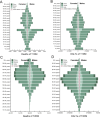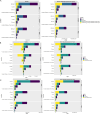Comparative diabetes mellitus burden trends across global, Chinese, US, and Indian populations using GBD 2021 database
- PMID: 40200037
- PMCID: PMC11978961
- DOI: 10.1038/s41598-025-96175-4
Comparative diabetes mellitus burden trends across global, Chinese, US, and Indian populations using GBD 2021 database
Abstract
Diabetic mellitus (DM) poses a significant challenge and stress to global health, comparing the burden of disease in the world's three most populous countries while projecting changes in trends in age-standardized rate (ASR) -deaths and disability adjusted life years (DALYs) up to 2050. Using GBD2021 data, we examined DM trends in China, US, India and globally for 1990-2021, and projected deaths and DALYs for DM (types 1 and 2) for 2022-2050 using Bayesian age-period-cohort (BAPC) model. It was found that the ASR-DALYs and deaths for T1DM are trending downward globally, while those for T2DM are trending upward. In terms of gender differences, the burden of T1DM by gender was insignificant, whereas the burden of disease was significantly higher in men with T2DM than in women. The burden of disease for T1DM peaks around the ages of 40-44 years, while the burden of disease for T2DM peaks at 65-69 years. Population growth and ageing are major factors influencing the disease burden of diabetes. The projection of ASR-deaths and DALYs globally for 2022-2050 showed a decreasing trend in T1DM and an increasing trend in T2DM (especially in China and India). The increasing burden of T2DM disease globally and in three countries by 2050 should be taken seriously.
Keywords: Burden; Diabetes mellitus; Disability adjusted life years; Global epidemiology; Mortality.
© 2025. The Author(s).
Conflict of interest statement
Declarations. Competing interests: The authors declare no competing interests. Ethics statement: This research does not contain any studies involving human or animal participants.
Figures










References
-
- Chew, N. W. S. et al. The global burden of metabolic disease: data from 2000 to 2019. Cell. Metab.35 (3), 414–28e3. 10.1016/j.cmet.2023.02.003 (2023). - PubMed
Publication types
MeSH terms
Supplementary concepts
Grants and funding
LinkOut - more resources
Full Text Sources
Medical

